- Offensive Techniques & Strategies
On Ball Defense
What to Discover or Recall:
Ball pressure is the single most important element of team defense.
Individual "on Ball" defense is comprised of three basic fundamentals: Pressuring the Player with the ball, containing a dribbler, and attacking the picked up dribble.
In guarding a player with the ball, the defender must attack, rather than react to offensive actions.
On-Ball defenders must maintain a low, "Nose on Chest" stance with very active hands and feet.
Defenders must possess a working knowledge of the techniques on how to contain a dribbler both in the open court and in the front court.
Defenders must also understand the importance of protecting the "Elbows" & "Blocks" on dribble penetration to the basket.
| Stance & Footwork | Defending Dribble Penetration | Taking a Charge | Review | Drills for Skills
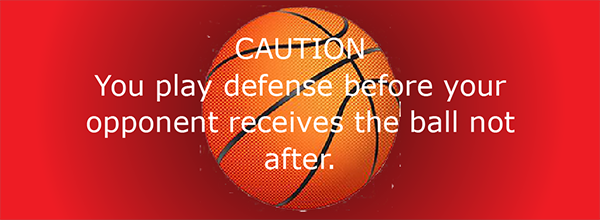
In forcing the opponent out of their normal operating areas, it creates offensive spacing problems which benefit the defense.
1. Post passes are longer and more difficult.
2. Outside shots are longer.
3. It takes an extra dribble or two to reach the basket.

Pressuring the Player with the Ball
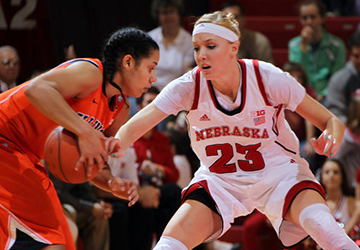
In guarding a player with the ball, defenders must attack, rather than react to offensive actions. Pressuring the ballhandler makes passing and dribbling more difficult, and increases the chances of an offensive mistake.The defender must eliminate the "Triple Threat" (shot, pass, drive) by taking away the shot and pass options, and forcing the ball hander into dribbling. The reason being is that the offense can "put points on the scoreboard" off a shot or pass, but cannot score when dribbling.
Basic Stance & Footwork
Individual Fundamentals Required: Defensive Concepts & Principles
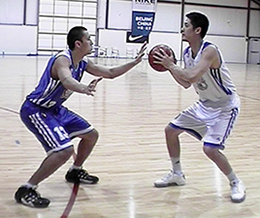
Stay low in a bent knee, "Nose on Chest" upright position. Do not lean or reach. Have both hands up keeping fingers spread taking away the opponent's shot and post pass options. Maintain active feet. Keep feet moving with small chatter steps. Do not ever stand flat footed.
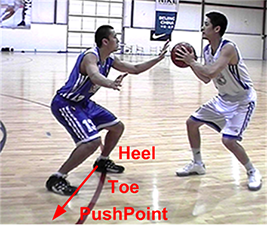
The defender's feet should be in a "heel/toe/pushpoint" alignment influencing the ball handler towards a sideline or trap zone preventing any dribble penetration into the middle of the court. In influencing a ball handler to a sideline or the baseline it not only cuts down on the size of the court to defend, but also initiates helpside defense.
Have Very Active Hands
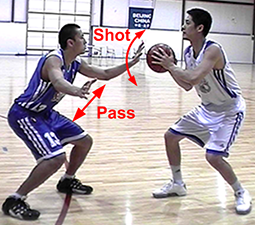
When guarding the player with the ball, both hands should be held up in a shoulder high, martial arts position where they can strike out and recover with lighting speed. The defender must have very active hands and must be ambidextrous using both hands equally well. Having both hands up where the officials can see them also eliminates fouls.
One of the defender's hands should be held up close to the ball tracing (following) the ball movement. The other hand is held lower and slightly to the side waving to distract the passer and to cut off the passing lane into post. Stay on balance and do not reach.
Defending Against Offensive Moves & Fakes
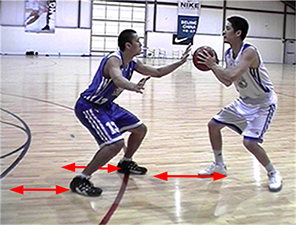
Since almost all offensive moves (jab steps, crossovers, reverse pivots, etc.) are predicated in getting past a defender, rather than trying to counter every offensive move, defenders should simply back off (build cushion) and protect against drives. Since most offensive players tend to over stride when executing jab steps and crossovers, it reduces the effectiveness of the moves and provides the defender with a slight advantage.
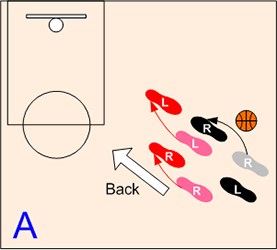
"Back"
If the ballhandler takes a jab step toward the basket, the defender must protect against the drive by countering with a quick, two footed drop (low 12" hop) maintaining a "Nose on Chest" stance.
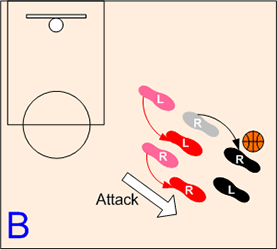
"Attack"
When the ballhandler steps back and re-assumes a triple threat position, the defender immediately closes back out using a quick, two footed short hop to an on ball position with both hands up.

Defending Against Dribble Penetration
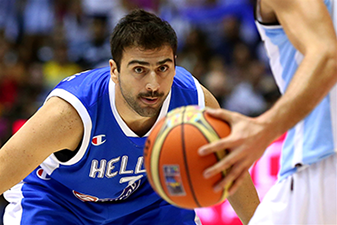
| Front Court | Back Court | Picked Up Dribble | Taking a Charge |
In today's basketball, most players are highly skilled in ball handling moves such as crossovers, between legs, spin and behind the back moves. There are now even personal trainers available that specialize in tutoring and developing player's individual offensive skills and moves. Therefore, defensive players must improve their skills accordingly. In defending against the dribble, it requires two different techniques. One in open or back court and the other on dribble penetration to the basket.
Defending a Dribbler in the Front Court
Importance of Protecting the "Blocks" & "Elbows"
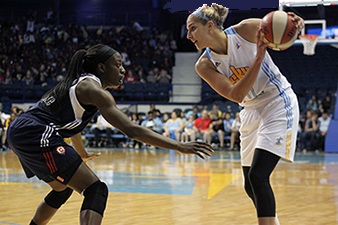
Rather than trying to counter every offensive move, defenders should just contain a dribbler since most offensive moves are predicated in getting past a defender. Once the ball handler initiates the dribble, the defender must stay down using knees apart, push or shuffle steps until ball handler picks up their dribble. Build cushion (space) against a quicker ball hander.
| Point Penetration | Wing Baseline Penetration | Wing Middle Penetration | Middle Adjustments |
Point Dribble Penetration - Protecting the "Elbows"
When the ball is in the middle of the court, it is vital for the defender protect the "Elbows" and to force the ball hander to a corner pushpoint.
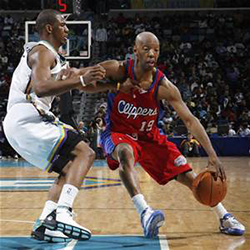
On point drives, defenders must defend with their legs. Both hands should be held above the shoulders to discourage and contest the shot or pass options. "Showing" or holding both hands high also eliminates referees from calling fouls.
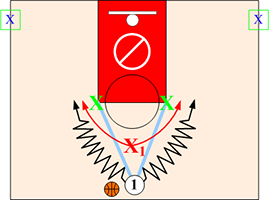
Corner Push
If the defender gets to the elbow first, then the offensive player is forced wide, outside the lane line, disrupting the dribble penetration and creating a difficult shot.
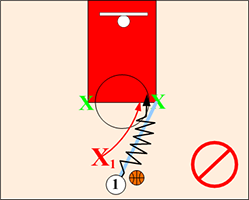
CAUTION
The defender should NEVER allow a ball handler to penetrate inside the elbow. If the offensive player gets to the elbow first, they can drive inside the lane to the basket for an easy shot using the backboard if necessary.
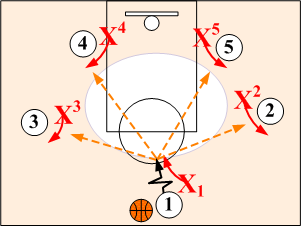
NOTE
On dribble penetration into the middle of the court ("Red Zone") the defender does not have any helpside support from the Off-Ball defenders since they are all in first pass denial positions.
Wing Baseline Penetration - Protecting the "Block"
When guarding a player on the wing, on a baseline drive whoever gets to the block first will win the battle. If the defender gets to the block first, the dribbler is forced in a difficult shot from behind the backboard or into a secondary trap zone. However, if the offensive player reaches the block first, it will allow them access to the backboard for an easy shot.
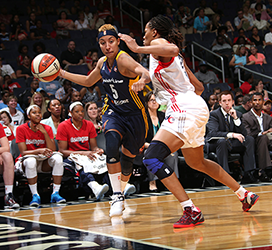
Defend with Legs
On baseline drives, defenders must defend with their legs using knees apart, quick push or shuffle steps. Both hands should be held above the shoulders to discourage and contest the shot or pass options. "Showing" or holding both hands high also eliminates referees from calling fouls.
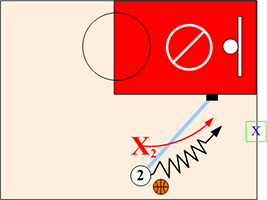
Baseline Push Point
When guarding a ball handler on the wing, the defender must force the dribbler below the block. To do this, the defender must stay down and push the dribbler to the baseline pushpoint.
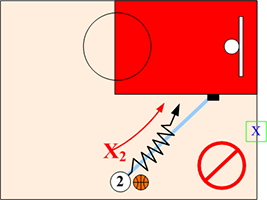
CAUTION
Never allow the dribbler to drive above the block to the basket.
Wing Middle Penetration - Protecting the "Elbow"
When a wing player dribble penetrates into the middle, the defender must protect the "Elbow" forcing the dribbler above the free throw circle. If the offensive player is allowed to penetrate into the "Paint" below the "Elbow," it will result in either a lay up, short pull up shot jumper, drop pass to post, a kick out pass to spot up shooters or a foul.
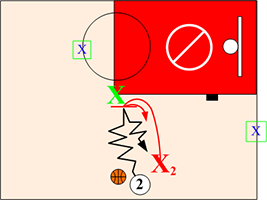
Block & Turn
When a wing tries to drive into the middle, immediately protect the "Elbow" and turn the dribbler back toward the sideline. Whenever possible try to take a charge.
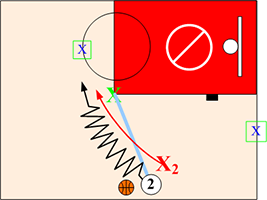
Force Above Elbow
If the defender is unable to turn the dribbler back to the sideline, the defender should beat the ball handler to the elbow and push to top of circle pushpoint.
Middle Penetration Adjustments
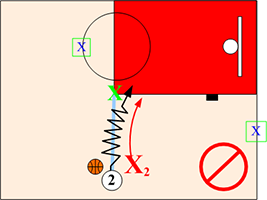
The defender should NEVER allow a ball handler to penetrate below the free throw line into the three second area. Defensively, nothing good ever happens on middle penetration.
It's all bad. Dribbling up the middle will result in a lay up, drop pass for an easy shot, short pull up jumper, a kick out pass for an open three point shot or a foul.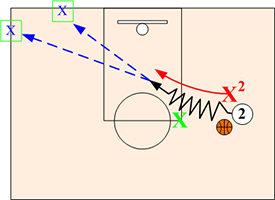
 Push Across to Opposite Sideline
Push Across to Opposite SidelineIf the wing drives into the three second area, the defender should push them across the three second area to the opposite corner or baseline pushpoint keeping both hands up near the shoulders in the martial arts "Strike" position.
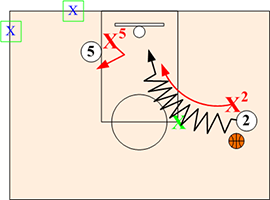
 Cede the Shot - Do NOT foul
Cede the Shot - Do NOT foulWhen the defender is beaten badly, it is best just to give up the shot and rebound. Driving shots down the middle are not easy. Even if the shot is successful, all you have to do is score on the ensuing offensive possession to erase or cancel it out, and begin defense anew.
CAUTION: The worst thing that can happen in this situation is to foul the shooter.
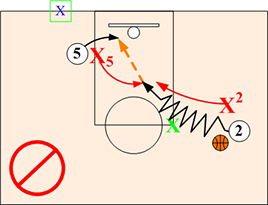
CAUTION
Do NOT rotate off a low post to help out on a drive. It is much more difficult to score on a driving shot the down middle than it is off a drop pass.
The post defender can bluff and fake at the dribble, but their primary responsibility is to deny any pass to the post and rebound.

Containing a Dribbler in the Open Court
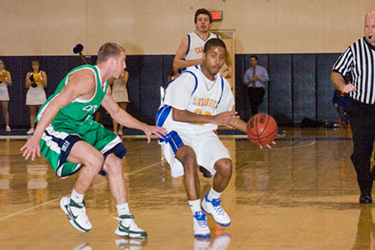
In the backcourt, the defender should contain a dribbler by assuming a low "Nose on Chest" position and pushing them toward a sideline pushpoint. In keeping the ball out of the middle it not only cuts down and minimizes the offensive operating area on the court, but, in addition, establishes helpside defensive support. As a result, by providing strong backside support, allows "On Ball" defenders to become more aggressive and confident by eliminating any fear of getting beat off the dribble.
Sideline Push
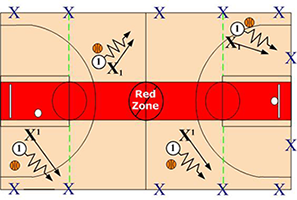
One of the most important principles of defense is to keep the ball out of the middle of the court ("Red Zone") by pushing the ballhander toward a sideline. In keeping the ball out of the middle it not only cuts down and minimizes the offensive operating area on the court, but it also establishes helpside defensive support eliminating any 1-on-1 offensive advantage. However, to be successful, defenders must possess a working knowledge of the defensive skills and techniques required to contain a dribbler in the back or open court, as well as, deny dribble penetration in the front court.
 Defensive Concepts & Principles
Defensive Concepts & PrinciplesBasic Stance
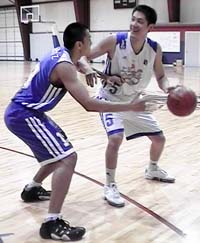
In defending a dribbler in the open or backcourt, the defender must maintaining a low "Nose on Chest"position and use quick, knees apart, push steps. The lead hand should be extended tracing the ball, and the trail arm near opponent's hip in a bent, elbow high position. Defender must stay on balance and not lean or reach.
CAUTION: Do not reach or go for the steal unless the ball handler commits a flagrant dribbling error.
Attacking the Dribble
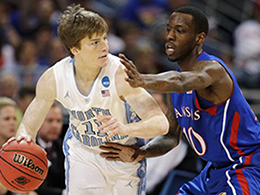
"Dig"
In attacking the dribble, the defender should use short, quick flicks ("Digs") with their trail or inside hand closest to the opponent. This will force the dribbler to protect the ball by keeping their body between the defender and the ball and dribble off their rear foot which neutralizes dribble penetration.
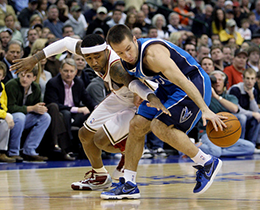
CAUTION
Use the trail hand in attacking the dribbler. Do NOT use the lead hand or reach. The lead hand is used to defend against and disrupt any attempt to pass the basketball. Also, reaching in for the ball with the lead hand will draw fouls.
Drop Step Change of Direction
Anytime a dribbler changes direction, the defender must execute a quick drop step move by pivoting on their lead foot and dropping their trail foot.
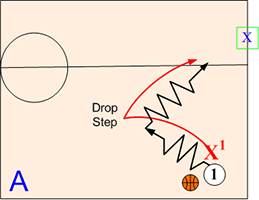
Change of Direction
When the dribbler changes direction, the defender counters by executing a quick counter drop step, the defender's hands also change roles with the trail hand becoming the lead hand, and the lead hand assuming the trail "dig" hand.
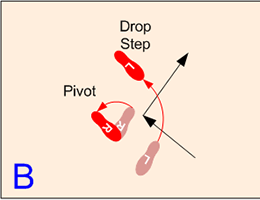
Drop Step Footwork
In executing a drop step, the defender pivots on the lead foot and drops the trail foot while maintaining a low "Nose on Chest" defensive stance.
Keeping Ball Out of the Middle
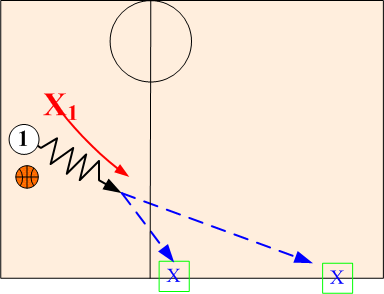
Containment
When the defender is unable to maintain leverage and force the ball handler to a desired pushpoint, just continue to force to the next pushpoint.
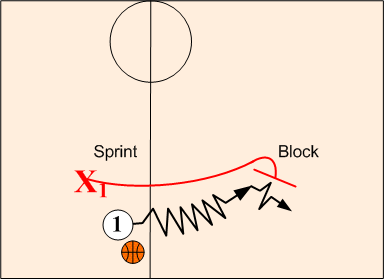
Sprint Release
If beaten off the dribble, the defender should sprint until they get one stride ahead, and then re-assume the nose on chest "Push" defensive position pressuring the dribbler to the next pushpoint.
CAUTION: Do not ever attack a dribbler from the side.
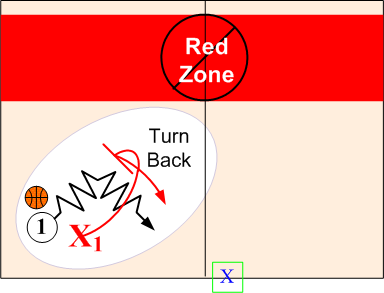
Block & Turn
If the ball handler should penetrate into the middle, the defender should physically block and turn the dribbler back to the sideline.
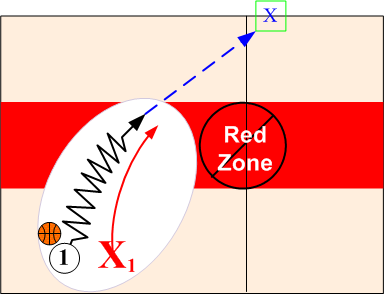
Push Across Red Zone
If/when the defender is unable to Block & Turn the ball handler, force the dribbler across the red zone to the opposite sideline.
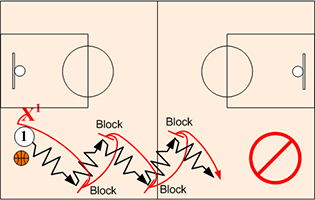
CAUTION
Continually "Bocking & Turning" in an attempt to disrupt and wear out a dribbler has the reverse effect. The amount of work and effort required by the defender is by far greater than that expended by the ball handler. This tactic might be effective against a poor ball handler. However, keeping the ball handler on a sideline creates a team effort, and increases the chance a poorly thrown pass that will be converted into an easy lay-up.

Attacking the Picked Up Dribble
Anytime a dribbler stops and picks up the dribble, the defender must immediately and aggressively attack and smother the ball. The defender should exert maximum pressure by crowding the opponent and tracing (following) the ball with both hands. Force the opponent into making a bad pass or, better yet, taking a valuable time out.
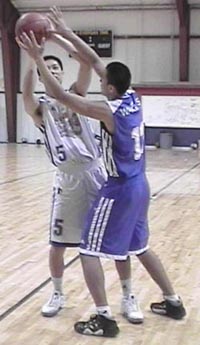
Smother the ballhandler by crowding and straddling the ball handler's pivot foot. Force the ball handler to pivot away from the basket in order to protect the ball. Trace the ball with both hands in order to disrupt the passer's vision and concentration.
CAUTION: Pressure the opponent hard, but do not foul.
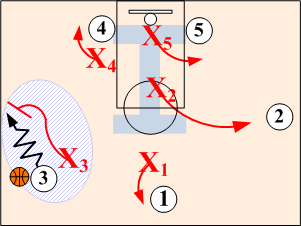
Automatic Close Outs
Anytime a dribbler picks up their dribble, the On Ball defender should immediately Jam and smother the ball hander, and all Off Ball defenders should close out and take away all passing lanes.

Taking an Offensive Charge
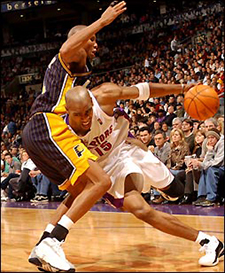
Anticipating and taking an offensive charge is a "Really Big Play" (RBP) in basketball. It not only takes away a potential basket and creates an offensive turnover, but it also assesses the offensive player with an additional penalty of a personal foul. By knowing how to properly take a charge, it not only prevents injuries, but, in addition, players are more likely to take charges during the game.
Establish Good Position
When taking a charge, it is important to try to establish good defensive position by squaring up before the ball handler can get into a shooting motion, preferably outside the three second area. Officials have a tendency to call blocks rather than offensive charges inside the 3 second area. In blocking foul is called when the defender is outside the free throw lane, it will be a non-shooting foul (unless in the bonus).
Prevent Injuries
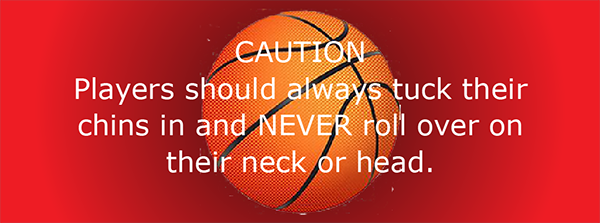
In taking a charge it is the utmost importance to eliminate injuries. On contact, the defender must first be taught to give on contact by tucking their chin into their neck and lowering their center of gravity by sitting down. If, the defender remains rigid and does not give on contact, injuries to one or both players are likely to occur.
Keeping arms at side, the defender must fall backwards landing on their buttock, never on their back, head or shoulders. Players should also be taught to avoid falling on their wrists or hands. However, to absorb the contact, they can use their hands and feet to push backward after hitting the floor.
Coaching Tips:
Use mats when teaching players to take a charge.
In practice have players "Bear Hug" the opponent instead of taking a charge.
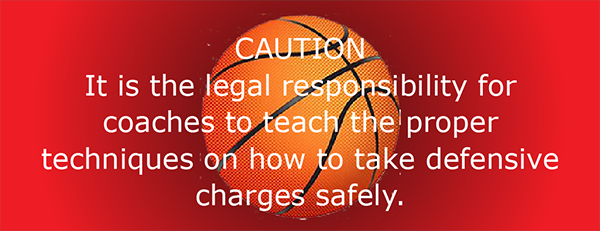
 Personal Liabilities Inherited with Coaching
Personal Liabilities Inherited with CoachingAvoid Flopping
Players should never be encouraged to flop or fake taking a charge. Unfortunately, there are officials that will reward defenders for flopping. However, flopping is unethical and not part of the game. There is enough contact and injuries in baseball already without purposely creating more.
NOTE: The NBA is now leveling fines for flopping. However, flopping can be prevented simply by the officials not blowing their whistles on a flop. If the defender falls to the floor, it will result in a five on four offensive advantage and an easy basket. As a result, defenders will quickly learn not to flop.

In Review
The success of any defense is totally dependent on individual player defensive skills and techniques.
Obviously, in the game of basketball, the offensive player has a superior advantage over a defensive player. However, sound defensive fundamentals and teamwork can neutralize this advantage.
Pressuring the Player with the Ball
Ball pressure is the single most important element of team defense.
To be successful, players must possess a working knowledge of the basic defensive concepts and fundamentals.
"On Ball" defensive fundamentals are comprised of three basic components: Pressuring and attacking the player with the ball, containing a dribbler and attacking the picked up dribble.
Pressuring the ballhandler makes dribbling and passing more difficult, and increases the chances of an offensive mistake.
When guarding a player with the ball, the defender should attack, rather than react to offensive actions.
The defenders should influence ball handlers to the closest sideline or baseline pushpoint. In keeping the ball out of the middle of the court (“Red Zone”), it not only reduces the offensive operating area, but it also creates helpside defense.
Defenders should constantly anticipate and immediately attack any player that picks up their dribble.
Defenders must have a hand up and contest every shot. Since shooters know where the ball is going as soon as it leaves their hand, they must be boxed out.
Taking a charge is a really big play in basketball. However, in taking a charge, players need to be taught to absorb contact by tucking their chin in and executing a shoulder roll.
Containing a Dribbler
One of the most important principles of defense is to keep the ball out of the middle of the court. Defensively, nothing good ever happens on middle penetration.
In keeping the ball out of the middle it not only minimizes the offensive operating area, but it also establishes helpside defensive support.
Defend the dribbler with your legs. Do not reach. Move your feet!
On drives to the basket, hold both hands up above the shoulders to contest the shot or pass. "Showing" or holding both hands high also eliminates referees calling fouls.
On dribble penetration, it is important that the defender protect the "Elbows" and "Blocks". Do not allow the dribbler penetration into the three second area.
In the open court, do not ever attack a dribbler from the side. Sprint ahead.
When the defender is unable to maintain leverage and force the ball handler to a desired pushpoint, just continue to force to the next pushpoint.
Do NOT foul a shooter. When the defender is beaten badly, cede the shot.
Do NOT rotate off a low post to help out on a drive since it is much more difficult to score on a driving shot the down middle than it is off a drop pass.
Team defense does not only eliminate one-on-one isolations and player mismatches that may occur during a game, but it also provides defenders with strong, helpside support and quick hitting double teams which, in turn, allows defenders to exert more pressure on the ballhander without any fear of getting beat.

Drills for Skills
Like their offensive counterparts, individual defensive skills must be broken down, practiced and refined on all levels of the game.
Individual Defensive Drills - Click Here
Return to Player Development - Click Here
Return to Defensive Strategies - Click Here
Return to HoopTactics - Click Here
© 2026 HoopTactics All Rights Reserved.
